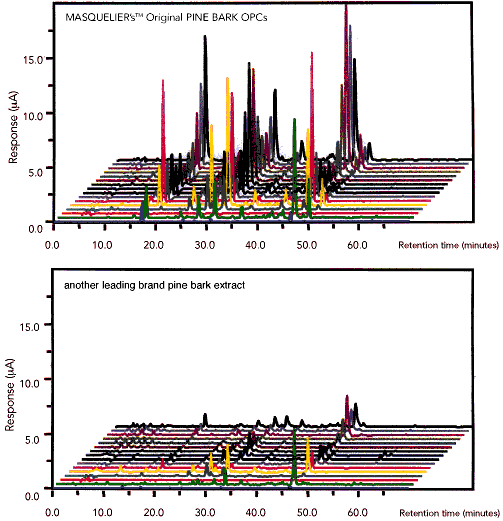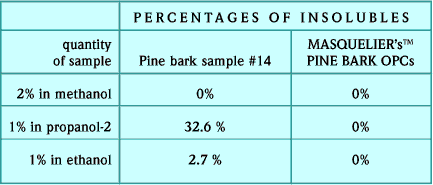|
***OPC Results and Conclusions***

Antioxidant activity
The ECA chromatograms represent a comparison of MASQUELIER's Original
PINE BARK OPC and another leading brand pine bark product.
Test conditions and amounts of samples were identical. Results
are displayed on the same scale. Both samples exhibit comparable
positions of peaks, confirming that both samples are extracts
originating from similar source pine bark materials. However
the other leading brand pine bark extract (sample #14 in the
Antioxidant Table) has significantly lower amounts of antioxidant
compounds per unit weight. The rest of the sample #14 extract
is likely to be non-antioxidant inert material. Original
PINE BARK OPC and another leading brand pine bark product.
Test conditions and amounts of samples were identical. Results
are displayed on the same scale. Both samples exhibit comparable
positions of peaks, confirming that both samples are extracts
originating from similar source pine bark materials. However
the other leading brand pine bark extract (sample #14 in the
Antioxidant Table) has significantly lower amounts of antioxidant
compounds per unit weight. The rest of the sample #14 extract
is likely to be non-antioxidant inert material.
Antioxidant capacity
The ACAP-Trolox test was performed in addition to the ECA
test to establish a more balanced and certain assessment of
the antioxidant nature of the samples. Because no single test
can give a reliable impression of the antioxidant capacity
of a product, we used two reproducible and controllable tests
to evaluate antioxidant character of the samples. The fluorescein-derivative
antioxidant comparison with Trolox shows that the tested leading
brand pine bark-based extract (sample #14) has a little more
than half the antioxidant capacity (55%) of MASQUELIER's Original PINE BARK OPC (sample #6). The Trolox
test confirms that sample #14 is in the mediocre grape seed
extract category. Original PINE BARK OPC (sample #6). The Trolox
test confirms that sample #14 is in the mediocre grape seed
extract category.
Electro Chemical Activity (ECA) profiles of MASQUELIER's Original PINE BARK OPC and leading
brand pine-bark based extract. Original PINE BARK OPC and leading
brand pine-bark based extract.

Relative
values of 10 grape seed samples compared to
MASQUELIER's Original Grape Seed OPC
Original Grape Seed OPC
&
MASQUELIER's Original Pine Bark OPC
Original Pine Bark OPC
and
another leading Pine Bark-based product (sample #14)
expressed in percentages
When brought in comparison with MASQUELIER's Original OPC and 10
"grape seed extracts" (the 1997 comparative analysis),
pine bark-based sample #14 scores 55% on the ACAP-Trolox scale.
Sample #14 scores 23% on the Electrochemical Activity scale.
Sample #14 is only 30% as electrochemically active as MASQUELIER's Original OPC and 10
"grape seed extracts" (the 1997 comparative analysis),
pine bark-based sample #14 scores 55% on the ACAP-Trolox scale.
Sample #14 scores 23% on the Electrochemical Activity scale.
Sample #14 is only 30% as electrochemically active as MASQUELIER's Original
PINE BARK OPC and it is only 23% to 26% as electrochemically
active as MASQUELIER's Original
PINE BARK OPC and it is only 23% to 26% as electrochemically
active as MASQUELIER's Original GRAPE SEED OPC. The lower antioxidant activity of
sample #14 implies that a much higher dose of this product
would be needed to achieve an effect comparable to that of
MASQUELIER's
Original GRAPE SEED OPC. The lower antioxidant activity of
sample #14 implies that a much higher dose of this product
would be needed to achieve an effect comparable to that of
MASQUELIER's Original PINE BARK OPC. Original PINE BARK OPC.
Pine bark-based sample #14 belongs in the category of the
lower quality generic grape seed extracts.

Routine Quality testing
When dissolved in water or other specific test-liquids, the
limpidity (clearness, transparancy) of the solutions provides
a simple and good, easy to check indicator of the quality
and purity of MASQUELIER's Original OPC. Qualified manufacturers
standardly perform these solubility tests to check and monitor
the purity of their products. The level of insolubles in OPC type
extracts is an indicator of low quality and/or production
problems. High quality OPC extracts completely and perfectly
dissolve. The test-solutions remain limpid and clear. To the
contrary, low quality "OPC" extracts only partially
dissolve. The level of insolubles in these low quality extracts
is a strong indicator of their lack of quality and purity. Original OPC. Qualified manufacturers
standardly perform these solubility tests to check and monitor
the purity of their products. The level of insolubles in OPC type
extracts is an indicator of low quality and/or production
problems. High quality OPC extracts completely and perfectly
dissolve. The test-solutions remain limpid and clear. To the
contrary, low quality "OPC" extracts only partially
dissolve. The level of insolubles in these low quality extracts
is a strong indicator of their lack of quality and purity.
To check insolubles in as broad a range as possible, every
batch of MASQUELIER's Original OPC, from PINUS MARITIMA as well as from VITIS VINIFERA,
is checked by mixing a sample of it with methanol, propanol-2
and ethanol. In these three substances the MASQUELIER's
Original OPC, from PINUS MARITIMA as well as from VITIS VINIFERA,
is checked by mixing a sample of it with methanol, propanol-2
and ethanol. In these three substances the MASQUELIER's Original OPC extracts remain perfectly soluble and limpid.
The pine bark-based sample #14 shows high amounts of insolubles
in the propanol-2, as well as a significant amount of insolubles
in ethanol. Original OPC extracts remain perfectly soluble and limpid.
The pine bark-based sample #14 shows high amounts of insolubles
in the propanol-2, as well as a significant amount of insolubles
in ethanol.
Probably due to its different method of extraction, the industrial
quality of sample #14 is below the quality and purity of the
MASQUELIER's Original
OPC products. Original
OPC products.
The impurities found in sample #14 possibly are the non-antioxidant
compounds and they may be the cause of its poor antioxidant
performance. As on the point of the antioxidant capacity,
pine bark-based sample #14 belongs in the category of the
lower quality generic grape seed extracts where it comes to
purity.

|
![]()